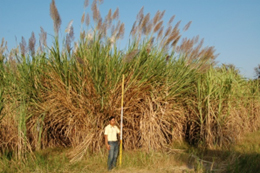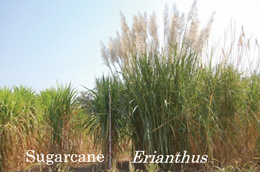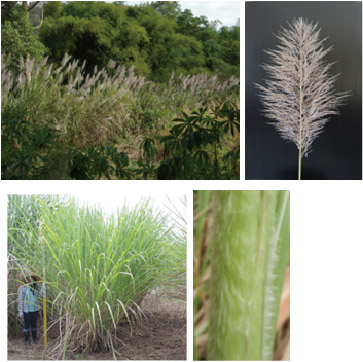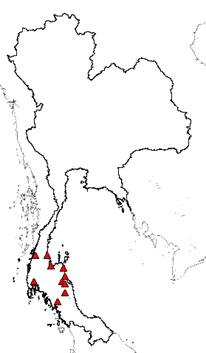JIRCAS-Erianthus Database

Welcome to the JIRCAS-Erianthus Database
The JIRCAS-Erianthus database is open-access database providing information relating to the morphological and agronomic characteristics of Erianthus germplasm in Thailand (for details see "What is Erianthus ?" and "Thai Erianthus germplasm"). These morphological and agronomic characteristics were characterized and evaluated as part of the JIRCAS sugarcane breeding project conducted by JIRCAS and the Khon Kaen Field Crops Research Center (KKFCRC) in Thailand. This database was developed to enhance the utilization of the wide genetic diversity of Erianthus germplasm for the purposes of sugarcane breeding, research work, and biomass utilization in Thailand and other countries.

Erianthus in Thailand (Photo by A. Sugimoto)
What is Erianthus ?
Erianthus is a tall perennial herb of the Gramineae family. It has C4 photosynthesis and is closely related to sugarcane (Saccharum spp. L.). Erianthus is classified into Old World species and New World species. The Old World species are widely distributed in the Mediterranean region, South Asia, South-East Asia, East Asia, and Oceania, and the New World species are distributed in North and South America. There are eight Old World species (E. arundinaceus, E. procerus, E. kanashiroi, E. bengalense, E. ravennae, E. hostii, E. elephantinus, and E. rockii [1]), which are considered to have played important roles in establishing sugarcane (genus Saccharum) as a member of the “Saccharum complex” [1, 2].
Erianthus has several useful traits such as high biomass productivity, vigorous ratooning, drought tolerance, water logging tolerance, adaptability to low-fertility soil, disease resistance, and pest resistance. Hence, Erianthus has come under great attention and is increasingly used as an important source of genetic resources in sugarcane breeding programs for broadening the genetic base and introgression of favorable agronomic characters from Erianthus to sugarcane. In addition, because of their high biomass productivity and wide ecological adaptability, Erianthus species have come into focus as an energy or fiber crop to produce electricity, liquid and solid biofuels, pulp, etc. [3].

Growth of sugarcane and Erianthus (Photo by M. Sato at Khon Kaen, Thailand)

Ratooning of Erianthus and sugarcane (Photo by Y. Terajima at Khon Kaen, Thailand)
Sugarcane breeding project in JIRCAS
Breeding to further improve sugarcane productivity and improve adaptability to adverse environments has been hampered by the narrow genetic base of sugarcane breeding materials. To overcome these constraints, utilization of wild germplasm is considered to be useful for their properties of higher biomass productivity and better adaptability to adverse environments.
JIRCAS and the Khon Kaen Field Crops Research Center in Thailand have jointly collected Erianthus germplasm from all over Thailand and have implemented the Sugarcane breeding project for development of “basic breeding techniques and scientific information” to enhance the utilization of the germplasm for sugarcane improvement in Thailand [4, 5, 6].
To effectively utilize Erianthus germplasm for sugarcane breeding, it is essential that genetic diversity be investigated and that useful breeding materials be identified. Although Erianthus germplasm has been collected in places such as India, Indonesia, and China, there is little public information about the characteristics of the collected germplasm and only limited use of the germplasm for breeding.
We developed this Erianthus database to share with other breeders and researchers the information on the morphological and agronomic data that were collected in the Sugarcane breeding project. Through the publication of this database, we expect to contribute to sugar and energy production throughout the world by enhancing the utilization of Erianthus for sugarcane breeding, research, and biomass utilization in Thailand and other countries.

Dying-off of sugarcane in dry season (Photo by Y. Terajima at Khon Kaen, Thailand)

Evaluation field of Erianthus germplasm (Photo by Y. Terajima at Khon Kaen, Thailand)
Thai Erianthus germplasm
JIRCAS and the Khon Kaen Field Crops Research Center in Thailand jointly collected Erianthus germplasm from all over Thailand from 1997 to 2010.
Thai Erianthus germplasm consists of germplasm from two species, E. procerus and E. arundinaceus. Erianthus arundinaceus, in particular, has a large diversity and can be classified into three types, each with different characteristics [4, 5]. Thailand has diverse germplasm of E. arundinaceus and E. procerus, exhibiting different ploidy and various morphological and agronomic characteristics. Therefore, this germplasm will be valuable in Thailand and worldwide.

Germplasm collection of Erianthus (Photo by S. Tagane & Y. Terajima at Thailand)

Wide variation of plant type in Erianthus germplasm (Photo by S. Tagane at Khon Kaen, Thailand)
Erianthus procerus
- Chromosome number : 2n = 40
- Heading period : December to February
- Characteristics : erect plant type, small stalk diameter, many stalks, no hair and much wax on the leaf sheath, and a lack of vegetative stalks (i.e., small buds and few or no root primordia). Heading period is late.
- Topography : Open hill slopes, forest edges, road sides
- Collection area : North to west Thailand


Erianthus arundinaceus (Type I)
- Chromosome number : 2n = 60
- Heading period : November to January
- Characteristics : Small stalk diameter, many stalks, very hairy leaf sheath. This type shows a wide variation of morphological characteristics.
- Topography : Open hill slopes, forest edges, road sides
- Collection area : All areas of Thailand except on the Malay Peninsula


Erianthus arundinaceus (Type II)
- Chromosome number : 2n = 60
- Heading period : December to February
- Characteristics : Relatively large stalk diameter, presence of vegetative canes (i.e., large buds capable of germinating and prominent root primordia), and heavy wax on the leaf sheath. Most individuals do not have hair on their leaf sheaths.
- Topography : Riverbanks and swamps
- Collection area : South Thailand


Erianthus arundinaceus (Type III)
- Chromosome number : 2n = 40
- Heading period : October to November
- Characteristics : Presence of vegetative canes similar to Type II but lacks wax on its leaf sheath, heavy anthocyanin on leaf sheath. Heading period is early.
- Topography : Riverbanks and swamps
- Collection area : South, east, north-east, and north Thailand


Acknowledgements
We would like to express our sincere thanks for the support and contribution of all the members and collaborators in the development of this database under the JIRCAS-KKFCRC collaborative sugarcane project.
Khon Kaen Field Crops Research Center, Department of Agriculture, Thailand
Werapon Ponragdee, Amarawan Tippayawat, Sangdaun Chanachai, Taksina Sansayawichai, Rianthong Pansaita, Peaingpen Sarawat, Somsit Juntarak, Jiraluck Phoomthaisong
Japan International Research Center for Agricultural Sciences (JIRCAS)
(https://www.jircas.go.jp/en)
Akira Sugimoto, Shuichiro Tagane (currently University of Kyusyu), Shinichi Tsuruta, Masakazu Hirata, Yasuteru Shikina, Koji Yamato, Yuto Hateruma, Mitsuru Kyan, Naomi Makiya, Maki Hoshi, Satoru Muranaka, Takanori Hayashi, Takeshi Kano, Kazuo Nakashima, Miyuki Iiyama
University of Tsukuba, Japan
(http://www.tsukuba.ac.jp/en/)
Hisayoshi Hayashi
D-blauer Strom LLC.
Yuki Hasunuma
JIRCAS sugarcane breeding project
Yoshifumi Terajima, Hiroko Takagi, Shotaro Ando, Shinsuke Yamanaka
Reference
1. Jackson, P., and Henry R. J. (2011). Erianthus. In C. Kole eds., Wild Crop Relatives: Genomic and Breeding Resources, Industrial Crops. Springer-Verlag. Berlin. 97-107.
2. Mukherjee, S. K. (1957). Origin and distribution of Saccharum. Bot. Gaz. 119: 55-61.
3. Terajima, Y., Gau, M., Uwatoko, N., Sugimoto, A. (2015). JEC1, a new variety of Erianthus with higher mechanical harvesting efficiency. Japan International Research Center for Agirucultural Sciences, Research Highlights. B-07. (https://www.jircas.go.jp/ja/publication/research_highlights)
4. Tagane, S., Ponragdee, W., Sansayawichai, T, Sugimoto, A., Terajima, Y. (2012). Characterization and taxonomical note about Thai Erianthus germplasm collection: the morphology, flowering phenology and biogeography among E. procerus and three types of E. arundinaceus. Genet Resour Crop Evol. 59:769-781.
5. Tsuruta, S., Srithawong, S., Sakuanrungsirikul, S., Ebina, M., Kobayashi, M., Terajima, Y., Tippayawat, A., Ponragdee, W. (2022). Erianthus germplasm collection in Thailand: genetic structure and phylogenetic aspects of tetraploid and hexaploid accessions. BMC Plant Biol 22, 45. https://doi.org/10.1186/s12870-021-03418-3
6. Terajima, Y., Ponragdee,W., Sansayawichai, T., Tippayawat, A., Chanachai, S.,Ebina, M., Sugimoto, A., Takagi, H., & Hayashi, H.(2022). Genetic variation in agronomic traits of Erianthus germplasm under multiple-ratoon crops in Thailand. Crop Science, 62,1531-1549. https://doi.org/10.1002/csc2.20697
7. UPOV. (2005). Sugarcane (Saccharum L.). International union for the protection of new varieties of plants (UPOV). Geneva. Switzerland. P3-29.
